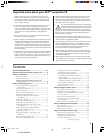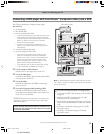
10
(E) 46/52/62HM95
Copyright © 2005 TOSHIBA CORPORATION. All rights reserved.
___________
HDMI, the HDMI logo and High-Definition Multimedia Interface are trademarks or
registered trademarks of HDMI Licensing LLC.
CableCARD™ is a trademark of Cable Television Laboratories, Inc.
TV back panel connections
For an explanation of cable types, see page 11.
1 ANT-1 (CABLE) IN and ANT-2 IN — Two inputs that
support analog (NTSC) and digital (ATSC) off-air antenna
signals and analog and digital (QAM) Cable TV signals.
Note: If you have an antenna only, connect it to ANT-1. If you have
both cable TV and an antenna, connect the cable TV to ANT-1 and
the antenna to ANT-2.
2 VIDEO 1 IN and VIDEO 2 IN — Two sets of standard
(composite) video and standard audio inputs plus optional
S-video inputs for connecting devices with composite video
or S-video output.
NOTE: Standard (composite) video and S-video cables carry
only video information; separate audio cables are required for a
complete connection.
3 ColorStream
®
HD-1 and ColorStream
®
HD-2 — Two sets
of ColorStream
®
high-definition component video and
standard stereo audio inputs for connecting devices with
component video output, such as a Toshiba DVD player
with ColorStream
®
. See pages 15 and 17.
Note: Component video cables carry only video information;
separate audio cables are required for a complete connection.
4 A/V OUT — Standard composite video and analog audio
outputs for connecting a VCR for editing and dubbing. See
page 18 for details.
5 Variable Audio OUT — Standard analog audio outputs for
connecting an analog amplifier with external speakers. See
page 20.
6 Digital Audio OUT — Optical audio output in Dolby
Digital or PCM (pulse-code modulation) format for
connecting an external Dolby Digital decoder, amplifier,
A/V receiver, or home theater system with optical audio
input. See page 20.
7 G-LINK
®
— For use with one of the enclosed IR blaster/
G-LINK
®
cables to enable the TV Guide On Screen
®
recording features. See page 25.
8 TheaterNet
™
(IR) OUT — For controlling infrared
remote-controlled devices through the TV. You can connect
up to two devices with either one of the enclosed IR blaster
cables, and then control the devices using the TV’s IR pass-
through or TheaterNet
™
(on-screen device control) features.
See pages 21 and 45.
9 Standard Audio IN — For use when connecting a DVI
device with analog audio output to one of the HDMI
inputs. See page 19. Also see item 10 below.
0 (2) HDMI
™
IN 1 and 2 — Two High-Definition
Multimedia Interface inputs receive digital audio and
uncompressed digital video from an HDMI device or
uncompressed digital video from a DVI device. See page 19.
NOTE: NEVER CONNECT THIS TV TO A PERSONAL
COMPUTER (PC). This TV is not intended for use with a PC.
!¡ (2) IEEE1394 — Two bi-directional digital IEEE1394
ports for connecting multiple devices with compressed
digital video. Because these ports are bi-directional, they can
be used for playback and recording. You can control your
IEEE1394 devices using the TV’s TheaterNet on-screen
device control icons. See pages 21–24 and 46.
NOTE:
• IEEE1394 cable carries both audio and video information;
separate audio cables are not required.
• NEVER CONNECT THIS TV TO A PERSONAL
COMPUTER (PC). This TV is not intended for use with a PC.
!™ CableCARD
™
slot — For use with a digital security card
and digital cable TV service (provided by your local cable
operator) to view encrypted digital programming. See pages
12 and 51.
Chapter 2: Connecting your TV
8
OUT
OUT
{
}
}
1
23549
07 6!¡ !™
HM95_R2_009-11_061505 6/27/05, 6:44 PM10


















